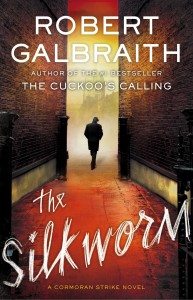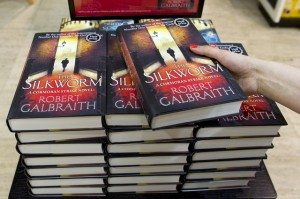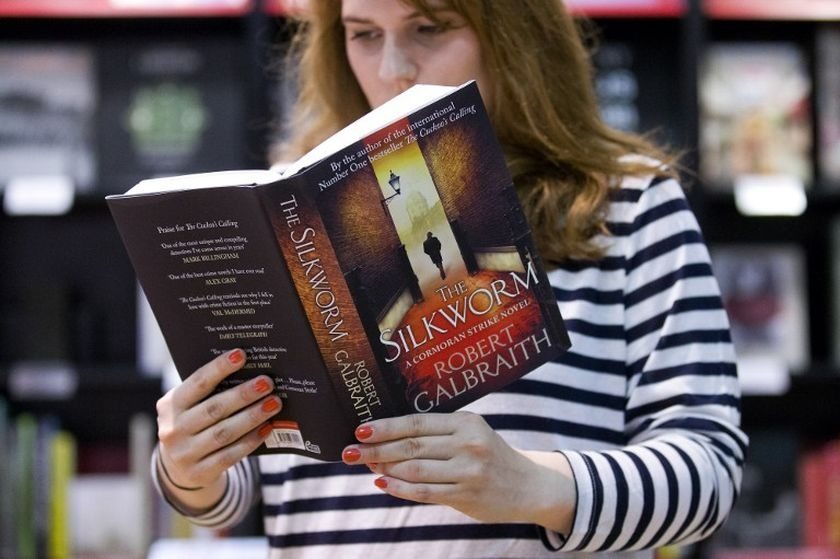Detective fever is spreading in Robert Galbraith’s ‘The Silkworm’
[dropcap]R[/dropcap]obert Galbraith – sorry, J.K Rowling – is back for another bite of the detective apple with a sequel to last-year’s exceptionally successful The Cuckoos’ Calling. If the Silkworm solidifies anything, it’s that Rowling was born to write crime fiction.
 The sequel picks up where its predecessor left off with private detective, Cormoran Strike seeing an increase in the popularity of his services after the events of the first novel, with his success in proving that Lula Landry was murdered. When libellous writer Owen Quine goes missing, Strike is embroiled in another intense and evocative mystery.
The sequel picks up where its predecessor left off with private detective, Cormoran Strike seeing an increase in the popularity of his services after the events of the first novel, with his success in proving that Lula Landry was murdered. When libellous writer Owen Quine goes missing, Strike is embroiled in another intense and evocative mystery.
Joined again by his assistant Robin Ellacott, the pair and their sometimes affectionate, sometimes turbulent relationship is once again the most appealing aspect about the series. Although Strike is always the main player, Robin gets an even greater chance to shine this time. Robin’s struggle to juggle her fracturing domestic life (her fiancé greatly disapproves of her boss) and growing interest in Strike’s criminal investigations directly echoes the ‘detective fever’ of the reader themselves. In doing so, Rowling taps into a literary history of crime and sensation fiction stemming all the way from the likes of Wilkie Collins’ The Moonstone. In her sequel Rowling creates such a rich ensemble of potential suspects, it is no wonder that, like Robin, the reader is compelled to read as quickly as possible to unearth the mystery.
It is a surprisingly gruesome mystery at times, with a case of a missing person quickly descending into a grisly tale of murder. Strike and Robin must immerse themselves into the literary world of publishing as they track down who might stand to be represented and exposed in Quine’s yet-to-be-published ‘Bombyx Mori’. Rowling clearly has fun turning on its head a world that she herself must be so familiar with since she crafts a literary scene filled with narcissistic writers and salacious editors and publishers. Motive is abundant in a range of characters masking the truth at every turn, frustrating the reader just as they believe Strike to be making progress.
 In my review for A Cuckoo’s Calling I hoped that Strike’s military past would be explored in greater detail and my wish is, in parts, answered. Figures from Strike’s past familial and military comrades feature in The Silkworm to flesh out Strike’s traumatic backstory. Readers finally discover more about the explosion that lead to the loss of Strike’s leg and meet some of Strike’s partially-estranged family members. Just like with Harry Potter himself, Rowling knows how to craft a multi-dimensional protagonist who sits on the periphery with a past that shadows his actions in the present.
In my review for A Cuckoo’s Calling I hoped that Strike’s military past would be explored in greater detail and my wish is, in parts, answered. Figures from Strike’s past familial and military comrades feature in The Silkworm to flesh out Strike’s traumatic backstory. Readers finally discover more about the explosion that lead to the loss of Strike’s leg and meet some of Strike’s partially-estranged family members. Just like with Harry Potter himself, Rowling knows how to craft a multi-dimensional protagonist who sits on the periphery with a past that shadows his actions in the present.
The greatest aspect of The Silkworm is its astute and confident depiction of Strike’s numerous interrogation scenes. The ability to get inside Strike’s head as he advantageously encourages his interviewee to divulge information willingly is a treat. Rowling really unearths the psychology of the detective and maps out in detail the moves and counter-moves that are necessary even in the briefest of exchanges to discover the required information. With Robin participating more significantly in the detective work this time, her and Strike, complement each other as the time-old and genre-popular ‘good cop/bad cop’. Indeed, Robin’s increasing friendship with Strike elevates her from the ‘plucky PA’ role she sometimes felt confined to in the original novel.
[pullquote style=”left” quote=”dark”]Rowling’s sequel is a novel which epitomises the ‘page turner’[/pullquote]
The Silkworm is the perfect read for the cool summer evenings. It is both entertaining and shocking in good measure, and its narrative is constructed with all the veneer that comes with Rowling’s great expertise as a stellar story-teller. The characters never fall flat and are depicted with a freshness that ensures they are not reduced to mere archetypal roles like ‘suspect number one’ but instead have a life beyond the page. The ‘life’ is one that should be all too familiar with the reader, with the novel taking place in the late winter of 2010. The book is peppered with references to the illegitimacy of the press which continues the mistrust Rowling holds towards the media industry in the wake of cases like the Leveson inquiry first demonstrated in the original novel.
Seven novels are planned for Strike and Robin so readers have time aplenty to continue on with their journey. As Robert Galbraith, Rowling goes from success to success with the eminently likeable pairing and is on her way to be a master of the very best of 21st century crime fiction.

Comments (1)
Astute review, with some strong points about crime writing in the 21st century. As a lifelong fan of the works of Agatha Christie, I am excited to see another author continue the tradition of the whodunit for a contemporary audience. Cannot wait to pick up more of Galbraith’s work. My one qualm with this piece is the constant references to Rowling. Yes, we know it is her and yes, we know that her continuing to write as Galbraith is a tongue-in-cheek response to her real identity being revealed, but it would have been nice if the writer here respected her decision to use a pseudonym. It doesn’t diminish the quality of the novel nor does it affect any of the observations made, but it would have been a nice homage to the author.